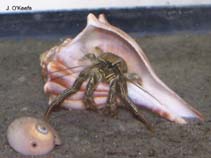Clibanarius vittatus (Bosc, 1802)
Thinstripe hermit| Native range | All suitable habitat | Point map | Year 2050 |

|
| This map was computer-generated and has not yet been reviewed. |
| Clibanarius vittatus AquaMaps Data sources: GBIF OBIS |
Classification / Names Common names | Synonyms | CoL | ITIS | WoRMS
Malacostraca | Decapoda | Diogenidae
Environment: milieu / climate zone / depth range / distribution range Ecology
Benthic; depth range 0 - 22 m (Ref. 97531). Tropical; 36°N - 28°S, 100°W - 33°W
Distribution Countries | FAO areas | Ecosystems | Occurrences | Introductions
Western Atlantic: from Potomac River, Virginia, the Gulf of Mexico and the Caribbean to Florianópolis, Santa Catarina, Brazil. Tropical to temperate.
Length at first maturity / Size / Weight / Age
Maturity: Lm ? range ? - ? cm
Life cycle and mating behavior Maturity | Reproduction | Spawning | Eggs | Fecundity | Larvae
Main reference
References | Coordinator | Collaborators
Markham, J.C. 2003 A worldwide list of hermit crabs and their relatives (Anomura: Paguroidea) reported as hosts of Isopoda Bopyridae. In R. Lemaitre and C.C. Tudge (eds.) Biology of Anomura. Proceedings of a symposium at the Fifth International Crustacean Congress, Melbourne, Australia, 9-13 July 2001. Memoirs of Museum Victoria 60(1):71-77. (Ref. 2782)
IUCN Red List Status
(Ref. 130435: Version 2025-1)
CITES status (Ref. 108899)
CMS (Ref. 116361)
Threat to humans
Human uses
Fisheries: commercial
| FishSource |
Tools
More information
Max. ages / sizes
Length-weight rel.
Length-length rel.
Length-frequencies
Mass conversion
Abundance
Internet sources
BHL | BOLD Systems | CISTI | DiscoverLife | FAO(Publication : search) | Fishipedia | GenBank (genome, nucleotide) | GloBI | Gomexsi | Google Books | Google Scholar | Google | PubMed | Tree of Life | Wikipedia (Go, Search) | Zoological Record



